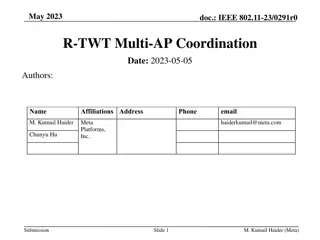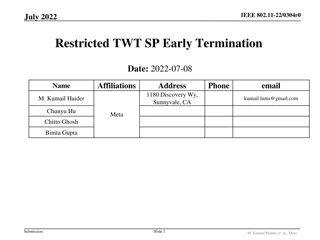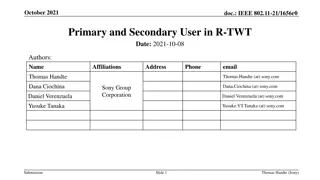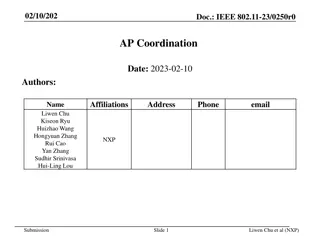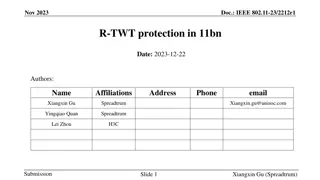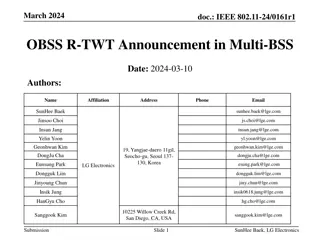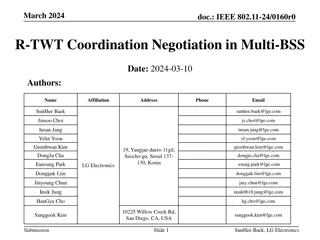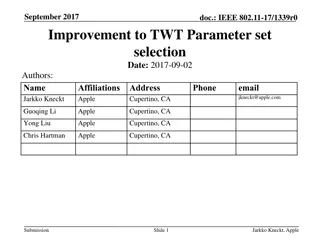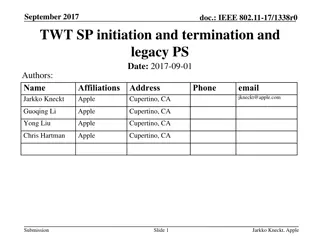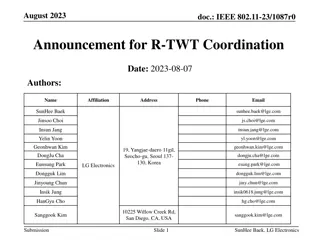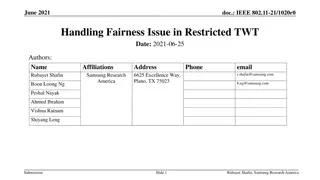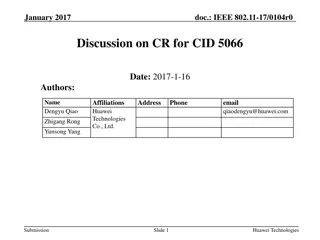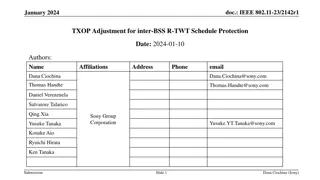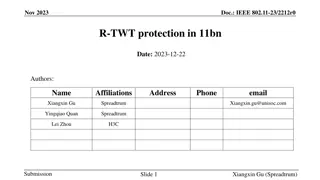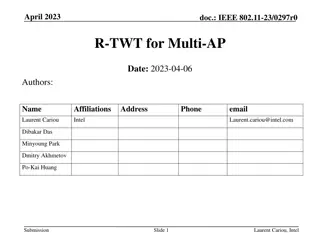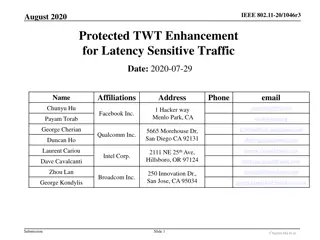
TWT-Based AP Power Save Proposal in IEEE 802.11-24
Explore the TWT-based AP power saving mechanism proposed in IEEE 802.11-24/0578r0 for improved efficiency. The submission discusses scheduled and unscheduled power-saving modes, dynamic AP states inside and outside TWT SPs, and the potential for a reverse scheme. Detailed timing information and focus on scheduled power-saving methods are highlighted along with the proposal for low capability and active states within TWT SPs.
Download Presentation

Please find below an Image/Link to download the presentation.
The content on the website is provided AS IS for your information and personal use only. It may not be sold, licensed, or shared on other websites without obtaining consent from the author. If you encounter any issues during the download, it is possible that the publisher has removed the file from their server.
You are allowed to download the files provided on this website for personal or commercial use, subject to the condition that they are used lawfully. All files are the property of their respective owners.
The content on the website is provided AS IS for your information and personal use only. It may not be sold, licensed, or shared on other websites without obtaining consent from the author.
E N D
Presentation Transcript
November 2024 doc.: IEEE 802.11-24/0578r0 TWT-Based AP Power Save Date: 2024-11-11 Authors: Name Yongsen Ma Affiliations Samsung Address 3655 N First St, San Jose, CA 95134, USA Phone email yongsen.ma@samsung.com Michail Koundourakis Samsung Mark Rison Samsung Srinivas Kandala Samsung Ravi Gidvani Samsung Submission Slide 1 Yongsen Ma et al., Samsung
November 2024 doc.: IEEE 802.11-24/0578r0 Abstract AP power save: scheduled, unscheduled, dynamic [1-17] Scheduled AP power save based on TWT [1-4, 12-17] Inside of TWT SPs: AP is in active state Outside of TWT SPs: AP is in doze state This submission, as a follow-up of [14, 15] Inside of TWT SPs: AP is in active state Outside of TWT SPs: AP is in low capability mode or in doze state May have option for reverse scheme: AP in low capability inside of TWT SPs and in high capability outside of TWT SPs Submission Slide 2 Yongsen Ma et al., Samsung
November 2024 doc.: IEEE 802.11-24/0578r0 Recap: AP Power Save AP power save in PPDU/TXOP/SP/BI levels by different options [14] Timing Information Timing Type and Pattern Example Start time, duration, interval, stop time Start time, duration, interval (persistent) Start time, duration (long) Start time, duration (short) Start time (w/o duration or stop time, persistent until explicitly terminated) When, how long and how often Long-term repeatable/periodic Using TWT Long-term repeatable/periodic Using TWT with Persistence subfield = 255 Long-term Short-term Long-term one-time/on-demand one-time/on-demand one-time/on-demand Using TTLM Using TWT in SP level or ICF in TXOP level Using OMI/OMN When and how long When Short-time one-time/on-demand Using ICF/CF-END in TXOP level Focus of this submission: scheduled AP power save by TWT [1-4, 12, 14, 15] AP in awake state during TWT SPs and in power save mode outside of TWT SPs Submission Slide 3 Yongsen Ma et al., Samsung
November 2024 doc.: IEEE 802.11-24/0578r0 Proposal: TWT-Based AP Power Save AP is in low capability mode or doze state outside of TWT SPs (this submission and [14, 15]) AP is in active state inside of TWT SPs May have option for reverse scheme: AP in low capability inside of TWT SPs AP in high capability outside of TWT SPs Submission Slide 4 Yongsen Ma et al., Samsung
November 2024 doc.: IEEE 802.11-24/0578r0 Outside of TWT SPs AP in doze state outside of TWT SPs (existing submissions [1-4, 12, 14, 15]) AP is not able to receive or respond outside of TWT SPs Legacy STAs assume AP is always available and may try to do frame exchanges outside of TWT SPs. Same for STAs that do not know AP is in doze state AP in low capability mode outside of TWT SPs (this submission and [14, 15]) AP may receive and respond AP may switch to high capability mode, upon receiving requests from upper layer or from other STAs Can reuse the high and low capability modes used for unscheduled/dynamic AP power save Can coexist with unscheduled/dynamic AP power save, both inside and outside of TWT SPs Submission Slide 5 Yongsen Ma et al., Samsung
November 2024 doc.: IEEE 802.11-24/0578r0 Inside of TWT SPs AP in active state inside of TWT SPs AP is operating in normal/high capability mode Pre-UHR STAs can operate in their normal/high capability mode as usual UHR STAs operating in normal/high capability mode do not need to send/receive mode switch request in ICF, do not need to switch between high/low capability modes, and do not need extra padding Submission Slide 6 Yongsen Ma et al., Samsung
November 2024 doc.: IEEE 802.11-24/0578r0 Adjustment of TWT Duration/Interval/Persistence The AP may adjust the TWT Duration/Interval/Persistence to change how long/often for the AP operating in low capability and high capability It can coexist with dynamic/unscheduled AP power save and enhance each other For low traffic/channel load, or low performance requirement, or high power save requirement Longer duration for AP in low capability mode, or AP in low capability by default Mode switch requests in ICF from AP/STA to let the AP switch to high capability mode when needed For high traffic/channel load, high performance requirement, low power save requirement, or too many/frequent capability switch requests Longer duration for AP in high capability mode, or AP in high capability by default Reduce overhead from mode switch requests, mode switch operations, and extra padding Submission Slide 7 Yongsen Ma et al., Samsung
November 2024 doc.: IEEE 802.11-24/0578r0 TWT-Based and Unscheduled/Dynamic AP Power Save (1/2) Unscheduled/dynamic power saving has three aspects capability information; enablement/disablement; capability switch request/response and I-FCS/padding in ICF/ICR. Pre-UHR STAs do not understand these new signaling/procedure. So when there are pre-UHR STAs present, the AP may enable unscheduled/dynamic power save: pre-UHR STAs would operate in low capability disable unscheduled/dynamic power save: reduced power save benefit, or frequent enablement/disablement actions with increased complexity when pre-UHR STAs come and go. Many IoT devices would be pre-UHR STAs for a long time. Submission Slide 8 Yongsen Ma et al., Samsung
November 2024 doc.: IEEE 802.11-24/0578r0 TWT-Based and Unscheduled/Dynamic AP Power Save (2/2) TWT-based AP power save can be used to enhance the enablement/disablement operations for unscheduled/dynamic AP power save. Pre-UHR STAs can understand the enablement/disablement (indirectly by reusing TWT), so they can operate in normal/high capability within TWT SPs. UHR and post-UHR STAs can also operate in normal/high capability within TWT SPs without capability switch request/response and I-FCS/padding. The enablement/disablement operations can be more efficient, smooth and flexible. It is aligned with TGbn SP (Scheduled periodic power save on AP side with Broadcast TWT ID = 0 and Responder PM Mode = 1), and the only difference is that the AP may operate in low/high capability outside/inside of TWT SPs. It can be enabled by scheduled periodic power save and DPS enablement/disablement. Slide 9 Submission Yongsen Ma et al., Samsung
November 2024 doc.: IEEE 802.11-24/0578r0 Options for Signaling: Reuse Existing Frame/Element To indicate that AP operates in low capability mode outside of TWT SPs AP needs to indicate that a TWT is associated with certain capability modes The indication can be in existing frame/element or in a new frame/element Reuse existing frame/element Option 1: TWT element: Broadcast TWT Recommendation field value: 5-7 are reserved Option 2: TWT Information Extension element: Control field: B1-B7 are reserved; B-TWT Info field: B5-B7 are reserved Other options May not be needed if another field/element already contains the indication Submission Slide 10 Yongsen Ma et al., Samsung
November 2024 doc.: IEEE 802.11-24/0578r0 Reuse TWT Element for Signaling Option 1: Use Broadcast TWT Recommendation field to indicate that the TWT is associated with certain capability mode. Values 5-7 are reserved Submission Slide 11 Yongsen Ma et al., Samsung
November 2024 doc.: IEEE 802.11-24/0578r0 Reuse TWT Information Extension Element for Signaling Option 2: Use Control field or B-TWT Info field to indicate that the TWT is associated with certain capability mode. More freedom/flexibility than reusing TWT Element, but with higher overhead Submission Slide 12 Yongsen Ma et al., Samsung
November 2024 doc.: IEEE 802.11-24/0578r0 Options for Signaling: Define New Frame/Element To indicate that AP operates in low capability mode outside of TWT SPs Define new frame/element Option 1: Define in UHR Capabilities element, may use two UHR Capabilities elements Option 2: Define a capabilities element to indicate high and low capability modes Other options Need to indicate that the capabilities element is used together with a certain TWT May send OMI/OMN together with a certain TWT May reuse the definition of high and low capability modes from unscheduled/dynamic AP power save, which can be announced in Beacons or ICF [8, 10, 12] Submission Slide 13 Yongsen Ma et al., Samsung
November 2024 doc.: IEEE 802.11-24/0578r0 Conclusion This submission presents a mechanism for scheduled AP power save Inside of TWT SPs: AP is in active state Pre-UHR and UHR STAs can operate in normal/high capability, without mode switch request, mode switch operation, or extra padding Outside of TWT SPs: AP is in low capability mode or in doze state AP may operate in low capability mode with reduced power consumption AP may receive and respond to certain frames/requests AP may switch to high capability mode, upon receiving requests from upper layer or other STAs It can be used to enhance the enablement/disablement operations for unscheduled/dynamic AP power save: to be more efficient, smooth and flexible May have option for reverse scheme: AP in low capability inside of TWT SPs AP in high capability outside of TWT SPs Slide 14 Submission Yongsen Ma et al., Samsung
November 2024 doc.: IEEE 802.11-24/0578r0 References [1] 23/0010r0, Considerations for enabling AP power save, Alfred Asterjadhi (Qualcomm Inc.) [2] 23/2040r1, Enabling AP power save_follow up, Alfred Asterjadhi (Qualcomm Inc.) [3] 23/0015r0, AP MLD power management, Liwen Chu (NXP) [4] 23/1936r0, AP MLD power save follow up, Liwen Chu (NXP) [5] 23/0225r0, Considering Unscheduled AP Power Save, Guogang Huang (Huawei) [6] 23/1420r0, Expedited Wake-up in Unscheduled AP MLD Power Saving, Juseong Moon (KNUT) [7] 24/0451r0, AP state transitions in DPS mode, Vishnu Ratnam (Samsung Electronics) [8] 24/0833r0, Dynamic Power Saving for AP, Geonhwan Kim (LG Electronics) [9] 24/0671r0, Enhancements on AP Power Save, Sanghyun Kim (WILUS) [10] 24/1146r0, Considerations on AP Power Save Mode, Jerome Gu (Clourney Semiconductor) [11] 24/0782r1, AP power saving, Chaoming Luo (OPPO) [12] 24/0659r1, Thoughts on AP Power Save, Binita Gupta (Cisco Systems) [13] 24/0589r1, Dynamic TID-To-Link Mapping for AP MLD Power Save, Yongsen Ma (Samsung) [14] 24/0813r0, Discussions on AP Power Save, Yongsen Ma (Samsung) [15] 24/0097r0, AP Power Management - Follow up, Yongsen Ma (Samsung) [16] 23/1835r0, AP Power Management, Yongsen Ma (Samsung) [17] 24/1611r0, Power Save Capabilities, Manasi Ekkundi(Samsung Electronics) Submission Slide 15 Yongsen Ma et al., Samsung
November 2024 doc.: IEEE 802.11-24/0578r0 Straw Polls SP1: Do you support to define a mechanism in TGbn to allow AP enter and exit a low capability mode based on a schedule? Definition of low capability mode is TBD, e.g., BW=20MHz, NSS=1, and may reuse the definition from unscheduled/dynamic AP power save May reuse existing mechanisms, e.g., TWT and OMN/OMI Results Y: , N: , A: Submission Slide 16 Yongsen Ma et al., Samsung


